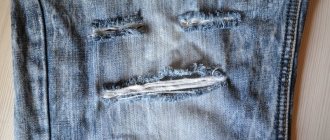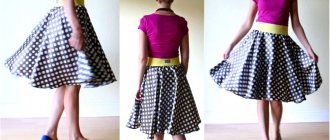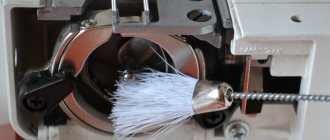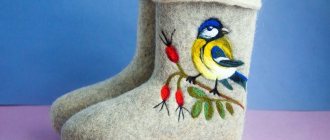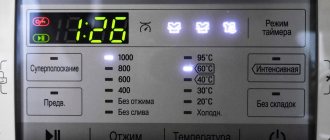Rating: No rating
Many women have a desire to sew for various reasons. Some want to sew things for themselves and their loved ones in order to save money, others want to have clothes that fit them perfectly, and still others simply want to sew something for the home, thereby creating coziness and comfort.
But not everyone knows how to sew, cut, develop a design, and cutting and sewing courses are not a cheap pleasure, so many set the goal of learning how to sew from scratch on their own.
I want to learn to sew, where to start?
The goal of learning to sew has been set, but where to start? We suggest first defining the main stages of this process:
- Firstly, you need to think through to the smallest detail the idea and design of the future product, including the type of fabric, color, shape, additional elements and decor. Ideally, sketch out a sketch that you understand.
- Secondly, you must understand that you practically cannot do without patterns, so you need to be prepared for the fact that you will need to make measurements, calculations and drawings.
- Thirdly, you must master the simplest functions of a sewing machine and learn how to make the basic elements of sewing. You can learn this thanks to master classes on the Internet, where all types of fabric finishing, neck and hem processing, how to sew in a zipper and make buttonholes, and much more are described in detail. Having worked through each such element on a piece of fabric, you will gain skills that will help you in the future.
And, of course, you need to prepare everything you need for this process:
- paper and pencils for creating a sketch;
- centimeter tape for taking measurements;
- square, ruler, patterns, paper with markings and a simple pencil for drawing a pattern;
- scissors, needles, pins and threads;
- additional elements for decoration: buttons, zippers, ribbons, braid, lace.
"TECHNOLOGY AND MATERIALS FOR SEWING PRODUCTION"
This is a textbook for primary vocational education institutions. Suitable for those who have already mastered all previous editions and are eager for new adventures. From here I learned important nuances of quality tailoring. There is no point in reading the entire book - only the section that corresponds to the current task. Then, looking at the picture, it will be clear what kind of fabric layers are shown in the diagrams: the brain will immediately transform them into your product. “Ahhh, so this is how it’s done!” - this reaction should accompany you when reading. I bought the book at Akademkniga.
How to learn to sew and cut from scratch yourself
When the idea for the future product is ready, you need to make a pattern. Of course, you can use ready-made (close to your idea) patterns from the Internet or sewing magazines, but we recommend trying another method.
To get a feel for and practice for those who have never dealt with sewing clothes at all, we recommend that you do not throw away your favorite things that fit you perfectly but have already been worn out, but rather rip them apart at the seams and use them as patterns. By ripping apart the finished product, you will also be able to consider all the finishing methods and repeat them in your new product.
But before sewing the cut parts of the product on a machine, we recommend that you do a light basting of the product and try it on in order to fit it to your figure, if we are talking about clothing, or to eliminate shortcomings.
Ways to learn to sew
There are several ways you can learn to sew and cut.
- Training in special courses on cutting and sewing. However, this is a costly method, because you will have to pay for training.
- You can buy books on designing and modeling clothes. With their help you can study everything in detail. There are a lot of such books today; you just need to choose a really good edition, where everything will be written in an accessible and understandable way.
- You can learn to sew using video lessons, purchasing a suitable CD, or studying materials on the Internet. There are many video courses that are distinguished by their accessibility and easy learning.
- You can try sewing using ready-made patterns from magazines. This is quite simple, because usually fashion magazines have detailed descriptions of the entire cutting and sewing process. To begin with, you should choose simple models, and then try a more complex level.
How to learn to sew on a sewing machine from scratch
In order to confidently use a sewing machine, you first need to study the instructions to understand how it works, what functions it has and how it all works. A hint for you can be numerous videos on the Internet that offer complete reviews of sewing machines of any modification.
The main stages of working with a sewing machine:
- thread;
- adjust thread tension;
- adjust the presser foot clamp;
- set the stitch type;
- perform various types of seams;
- be able to secure the thread at the end of the work.
All these points need to be worked out once and practice making different types of stitches, so that later you don’t stop at this while sewing.
How to learn to sew various interesting things
We offer you a selection of ideas that will tell you how to sew various things for yourself and for the home yourself.
How to learn to sew curtains and lambrequins yourself
You can beautifully decorate the windows in your apartment thanks to ready-made sketches and drawings that abound on the Internet:
- Take measurements from the window and cut the purchased tulle (or other fabric) as shown in the diagram.
- Finish the edges of the curtains with an overlocker or thin silk ribbon.
- Drape each piece and secure with one stitch along the edge.
- Sew a ribbon to this edge, but on the wrong side, for attaching to the cornice.
- Decorate the upper edge of all blanks with a thin ribbon to hide the junction of the ribbon and the tulle.
How to learn to sew dolls with your own hands
If you are planning to sew a doll yourself, but are still having difficulties with the sketch, we recommend finding ready-made patterns for dolls:
- Transfer all the elements of the pattern first onto paper, taking into account the scaling, and then onto the prepared pieces of fabric.
- First, mark each part, and then stitch all the seams on a machine.
- Then turn out all the parts and place the filler prepared in advance inside.
- All parts of the doll are sewn by hand using a hidden seam.
How to learn to sew underwear
When sewing underwear, you can use ready-made patterns, but you will need to take measurements very carefully, or you can retake the uniform from an old model that is no longer suitable for wear, but fits you well.
How to learn to sew dresses
When the sketch of the future dress is already ready, then you need to:
- take all measurements;
- create a drawing or use a ready-made pattern, editing it to fit your dimensions;
- transfer all the details of the dress from the patterns to the fabric, taking into account the direction of the longitudinal and transverse threads;
- cut out all the details of the dress with a margin of 1 cm for the seams;
- make an estimate of the entire product;
- try on the dress and mark with pins all the places that require correction;
- make a machine seam along all basting lines;
- process the edge of the hem, armholes and neckline;
- sew on buttons or a zipper.
OR MAYBE IT'S NOT WORTH IT?
But before I continue, I’ll say: if you can’t sew, don’t sew. From an economic point of view, this is not at all profitable. From an aesthetic point of view, it is difficult for a non-professional to achieve a perfect fit. In addition, choosing threads, fasteners, details to match, finding fabric of the right quality and color is a real problem in Minsk. And all the imperfect little things will reveal the handicraft nature of the product. But even if you are lucky and you select the materials and make straight lines, it may simply turn out that the thing does not suit you. Or it would fit well if it were a slightly larger size or with a slightly smaller sleeve width. I know that many girls who sew will now say: it’s not true, everything is OK with me. But when I see these works in person, I can assure you: ZARA with crooked stitches is better. That's fair. No offense.
Video with master class lessons
In this collection of videos you will find simple recommendations on how to learn how to sew various things for yourself and for your home, without spending a lot of time, effort and money.
- Video with a lesson on how to learn how to sew clothes from scratch at home.
https://youtu.be/rIXsemD3Ggw
- A video about whether it is possible to learn to sew on your own and where to start.
- A video about how to quickly learn to sew without spending years on training.
- Video course on how to learn how to sew curtains and lambrequins yourself.
- Video tutorial for beginners on how to learn to sew on a sewing machine.
- In this video you will learn how to sew a dress without a pattern.
- Video about how to process the edges of a product without an overlocker.
- In this video you will learn how to sew a sun skirt at home.
- Video tutorial for beginners on how to sew a doll with your own hands.
- This video is dedicated to how to sew a snood yourself.
- If you want to know how to sew a hat, watch this video.
- In this video you will learn how to sew bumpers into a crib and a blanket in the bonbon style.
- A short master class on how to sew a pillowcase with a flap.
We hope that our tips and recommendations will help you master the art of sewing in a short period of time, and you will be able to please yourself and your loved ones with beautiful handmade products. Tell us about your first steps in sewing and how quickly you mastered the process.
HOW I LEARNED
I have not completed any courses, but nevertheless I have been sewing for 20 years: shirts, blouses, jackets, sleeveless vests, coats, trousers, skirts, dresses, hats with earflaps and faux fur coats with and without insulation. Here, for example, is a women’s earflaps designed and sewn by me from woolen coat fabric and arctic fox fur, with padding polyester inside:
It all started with labor lessons at school. In the 1990s, many people were forced to look for additional income. Therefore, the world art culture in our country was led by an architect, and the work was carried out by a professional dressmaker. In the labor room there was a mannequin, an overlocker, 10 electric machines, an ironing board with a cord holder on a spring, a cutting table, ironing pads, a steamer and an iron. In fact, it was a workshop, and we saw how clients came, how measurements were taken, dresses and jackets were cut, how the sleeve cap took a rounded shape, how the lining was connected to the base. It was at school that I learned how to sew simple basic things well. Then I started buying magazines and books on sewing to create more complex projects. And during my student years, when I started writing about fashion and style in the media, I began to attend industry exhibitions and seminars on the design and construction of fashion products as part of my work. In addition, I ordered many books and magazines from the National Library. And all this time I continued to sew and unlace. Rip apart ready-made store-bought items to study the technology of sewing them from the inside. Those who sew need to do this constantly, since no books will tell you what is hidden under the lining of the products of real professionals.
